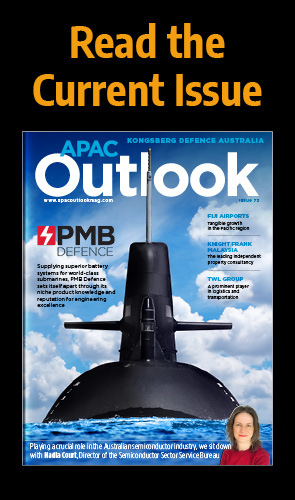
Money, for better or worse, has come to define civilizational development over thousands of years.
The original idea of currency, physical coins resembling a certain value, has stuck with us through time and to this day remains an important mode of transaction. Indeed, the term cash is king is thought to be a relatively new phrase coined in the late 1980s.
However, more recent times have seen an explosion in how money is represented and moved around. From smartphones and wearable payment rings to contactless cards and bitcoin, it is safe to suggest that cash, in the strictest sense, is not quite as regal as it was even a decade ago.
There are few better-placed individuals to comment on the subject that Rama Sridhar, Executive Vice President of Digital and Emerging Partnerships and New Payment Flows for Asia Pacific at Mastercard. We asked her about the future of cash and the particular role real-time payments (RTPs) will play across the region in years to come.
Asia Outlook (AsO): What made you want to pursue a career in finance? Likewise, what inspired you to join Mastercard?
Rama Sridhar (RS): I entered banking after almost a decade in technology. At the time, the sector was the sunrise industry of the mid-90s. An opportunity to get in at ground zero and build a career in one of the highest growth markets was an opportunity not to be missed. Because of my background in tech, I naturally gravitated towards technology-led payments products, which built the perfect launch for my career with Mastercard.
AsO: What is your take generally on the advancement of the payments industry across SE Asia? Would you say the region is a global leader?
RS: The convergence of smartphones, the digitalisation of commerce supported by large fintech investments, and the expansion of digital and financial inclusion in the region have created the perfect backdrop for electronic payments technology to proliferate in Asia.
Electronic payments are also increasingly a significant part of many regulators’ national digital agendas as they are a powerful tool for accelerating financial inclusion and expanding the digital ecommerce ecosystem. For example, many countries in Southeast Asia are developing domestic real-time payments systems such as Singapore’s FAST and PromptPay in Thailand. These allow consumers to transact 24-seven, 365 days of the year in real, or near real-time and decrease their dependence on cash.
As a result of these trends, there is tremendous growth momentum in the payments industry across Southeast Asia. Further, because many countries do not have long-standing legacy systems in place, Asia has a greater ability to leapfrog ahead compared to other regions. This allows it to lead in adopting new technologies more quickly and efficiently.
AsO: How are RTPs helping grow a cashless society? How cashless will/should society become?
RS: Real-time payments are the closest we have as an industry to matching the feeling of trust that cash provides as the point of a transaction. This immediate nature of real-time payments is critical for the financially excluded who value the reliability of having hard currency in hand. RTPs enable the rise of digital commerce in the region by creating a cash-like transaction experience that draws more users into the digital ecosystem.
The room for cashless transactions to grow in Asia is tremendous. Between 85 to 95 percent of transactions across the region’s markets are cash and we believe these should be digitalised to the maximum extent possible for a number of benefits. These include reducing the cost of printing and managing cash, bringing more transparency and accountability into economies and increasing the correlating tax benefits. Digitalisation of payments also supports greater financial inclusion of the economically under-resourced, especially women.
AsO: Can you provide me some context or background on Mastercard and RTPs across SE Asia?
RS: Vocalink, a Mastercard company, has successfully implemented a number of real-time advanced systems in Southeast Asia, including FAST in Singapore and PromptPay in Thailand. We also announced in April that BancNet, the national clearing switch operator for the Philippines payment system InstaPay, will tap into Mastercard’s expertise and next-generation real-time payments anti-money laundering (AML) technology to strengthen and expand its system.
The impact of these systems across the region are significant. The Bank of Thailand has stood behind a cashless economy agenda through the promotion of PromptPay, launched in 2017, and used the RTPs system to drive new efficiencies, including the disbursement of lottery system payments. In under two years, PromptPay has grown to more than 46.5 million users (65 percent of Thais) doing 4.5 transactions per day. In total, PromptPay has moved four trillion Thai Baht ($130 billion) across 800 million transactions.
AsO: Are you finding some industries are more open to adopting RTPs than others?
RS: Most RTP payments are currently peer-to-peer (P2P) or peer-to-small-and-medium-enterprise payments (P2SME). This is driving cash conversion at the lower pyramid of consumer payments. For example, 85 percent of transactions on Thailand’s real-time payments platform, PromptPay, are less than THB 5,000 (approximately $200) each, while 80 percent of India’s United Payment Interface (UPI) transactions are less than INR 1,300 (approximately $20) each.
However, RTP technology can be applied across all payment categories: B2B supplier payments; B2C payments such as legal settlements, insurance claims, wages; C2B payments such as hospital bills, utility payments, and point-of-sale purchases; and domestic P2P and cross-border remittances.
AsO: What must be done to expand the take-up of RTPs?
RS: While many successful RTPs solutions have flourished, there remains a critical lack of a uniform comprehensive infrastructure, and alleviating this will require countries to set up their own domestic infrastructure at a significant cost. This can range from $50 million to $1 billion.
Siloed practices of most digital payments players have also not encouraged comprehensive industry-wide government regulation in the space or the appetite to foster standardisation, and this has led to slower progress in promoting interoperability.
The speed and ease of RTP-based systems adds to security challenges as the velocity of transactions can lead to fraud and money laundering more quickly than ‘slow’ payment settlement systems that are coupled with more robust cybercrime tools and practices. The introduction of fraud and anti-money laundering (AML) screening solutions needs to be simultaneous to encourage confidence and adoption across the ecosystem.
To solve these issues and enable real-time transactions to fully materialise in Asia in a systematic, scalable and robust manner, the entire ecosystem needs to pull together to shape this opportunity collaboratively, knowing that the potential benefits from these efforts are great.
AsO: How is Mastercard helping to address some of these challenges?
RS: Through our acquisition of Vocalink, Mastercard has embarked on a multiyear journey of sustainably providing interoperable RTPs technologies globally. We offer a comprehensive set of RTPs solutions across three product layers.
The first is infrastructure. Mastercard offers the core RTP switch (called IPS) supported by a multi-identifiers proxy platform (MPP), with both built on the data-rich ISO 20022 messaging standard. The switch includes the core credit transfer message supported by approximately 20 other payment and non-payment messages including request to pay. Mastercard operates its RTP infrastructure through regional payments hubs spread across multiple regions which are connected to each other to enable global interoperability.
Payment applications APIs forms the second layer. Our APIs enable bank apps to become payment applications without relying on the use of third-party payments apps.
Third is data and analytics value-added services. We offer AML solutions and account and transaction scoring tools that assist in reducing fraud by tracking antisocial funding and suspected mule accounts.
AsO: Would you say the financial ecosystem needs to unify for RTPs to be fully exploited?
RS: For the use cases of RTPs to expand and reach their full potential in Asia, the entire ecosystem of established financial service players and digital newcomers must participate in efforts to develop RTP infrastructure, improve fraud monitoring, and encourage consumer adoption.
Specifically, there are four main issues that need to be addressed to realise the potential of RTPs.
Firstly, regulators and policymakers across Asia must promote RTPs standardisation, and coordinated policy efforts must encourage RTPs usage across a wide variety of transactions.
Second, critical use cases and revenue models must be identified for all industry players, in particular those adopted by traditional banks, to encourage broader RTPs adoption by all.
Further, cost-efficient, standardised infrastructure needs to be developed, ideally on a shared or distributed basis.
Finally, regulators must require use of intelligence-based analytics tools that identify potential fraud, money laundering, and safety and security risks, and industry participants need to use analytics – informed by large volumes of global data on transaction context and payer demographics and behaviours – to solve for security risks.
AsO: Looking ahead, what progress do you predict will be made in the next five years?
RS: We expect the future to be driven extensively by digital payments that are powered by real-time infrastructure and proxy services. The incorporation of artificial intelligence in real-time payments solutions, infrastructure and insights will be the next step.




















